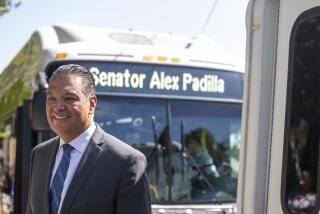TwinPorts Study Likely to Receive FAA Funding
- Share via
Boosting plans for a binational airport on Otay Mesa, a top federal official said Friday that the Federal Aviation Administration will be “very receptive” to San Diego’s request for a federally funded study of the proposal.
Carl Schellenberg, the FAA’s western regional administrator, said in an interview that he expects negotiations between federal and city officials to begin soon to establish the scope, timetable and cost of the first phase of detailed feasibility studies on City Councilman Ron Roberts’ plan for an airport straddling the U.S.-Mexico border between Otay Mesa and Tijuana.
“We’re very supportive of any attempt to help build airport capacity in San Diego,” Schellenberg said from his Los Angeles office. “This particular proposal happens to be a very good effort in that regard. San Diego has already made good progress, and we’re encouraging them to proceed. We’re going to be receptive, very receptive.”
Though Schellenberg emphasized that the cost and timing of the study cannot be accurately estimated until its scope is defined, he said the final price tag is likely to surpass $1 million, with the federal government contributing 90% of the cost and the city 10%.
Assuming that no unanticipated problems emerge, the city’s application for federal funds could be formally accepted and the study under way as early as late 1991, Schellenberg added.
Roberts hailed what he described as Schellenberg’s “thumbs-up” as yet another significant step forward for his so-called “TwinPorts” proposal, which calls for an international airport on Otay Mesa that would share runways and a control tower with Tijuana’s existing airport.
“With each step like this, we move further ahead than we ever have before” on previous airport proposals that have surfaced in the three-decade debate over the future of Lindbergh Field, Roberts said.
But City Councilman Bob Filner, an outspoken critic of the TwinPorts plan, characterized the FAA’s position as “a premature one” that could lead to “a giant waste of taxpayer’s money.”
“The key issue is not technical feasibility--it’s the political problem of getting Mexico’s approval,” Filner said. “There’s no assurance that’s going to happen--in fact, there’s good reason to believe that it never will. These studies are going to take years and years to complete and cost hundreds of thousands of dollars, and in the end, we’re not going to be any closer to a new airport than we are now.”
Under the TwinPorts proposal, a 12,000-foot runway and terminals would be built on the U.S. side of the border, next to Tijuana’s international airport. Linked by a 4,300-foot taxiway connecting the two parallel runways, the dual airports would operate separate terminals, customs and immigration checkpoints, agriculture and other inspection facilities. Planes could land or take off from either runway and would taxi to the appropriate terminal after landing.
If TwinPorts--which Roberts estimates could be operational by the turn of the century--becomes a reality, Lindbergh Field, where capacity is limited by its single runway and restricted traffic access, would remain open, operating primarily as a short-haul and commuter-service airport.
Brown Field, a small city-owned airport on Otay Mesa, would be closed and its operations relocated to the new border airport, or perhaps to Montgomery Field in Kearny Mesa.
Among the issues to be addressed in the feasibility study, Schellenberg said, two of the overriding questions concern the alignment of the airport’s runways and how to grapple with the thorny dilemma of managing air space that crosses international borders.
“The air space issue is an important one that needs to be resolved early in this process,” Schellenberg said. “I don’t think it’s a show-stopper, but unless it’s resolved, there’s no need to proceed to the other questions.”
In addressing the air space question, TwinPorts’ proponents will need to develop procedures outlining operation of the joint control tower--in particular, whether U.S. and Mexican air traffic control officials will be able to handle planes landing on either side of the border, or strictly those that land on their respective sides.
The precise configuration of the dual airports’ runways also is critical, Schellenberg noted, because of the safety, noise and environmental questions that hinge on it.
The TwinPorts proposal has galvanized opposition among nearby residents on both sides of the border, who complain that the airport will dramatically increase noise and traffic congestion in their communities, as well as raise serious safety concerns.
After the San Diego Assn. of Governments agreed last month to assist the city’s bid for federal funds to analyze the TwinPorts proposal, opponents sought to downplay the significance of that decision by contending that the FAA would not even accept a grant request from the city until Mexico formally agreed with the plan. To date, Mexican officials have simply expressed a willingness to study the proposal.
Normally, the FAA insists that proposed airport site questions be resolved before considering granting funds for feasibility studies, Schellenberg said.
“But those rules apply to airports built solely within the United States,” the FAA administrator explained. “It doesn’t really seem proper . . . to apply them to this one-of-a-kind airport straddling a border.”
Mexican officials have “demonstrated enough cooperative spirit” to date, he added, to justify proceeding with the feasibility studies.
“We’re in unchartered territory with this proposal,” Schellenberg acknowledged. “We certainly don’t have a pattern book for this case. . . . That’s what this (study) would start to do.”
More to Read
Sign up for Essential California
The most important California stories and recommendations in your inbox every morning.
You may occasionally receive promotional content from the Los Angeles Times.













